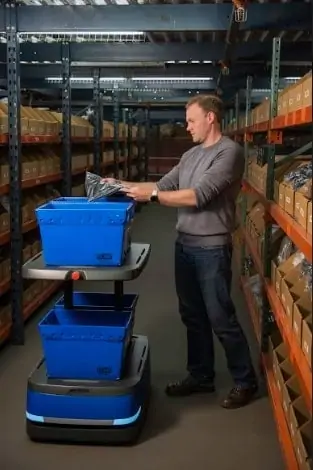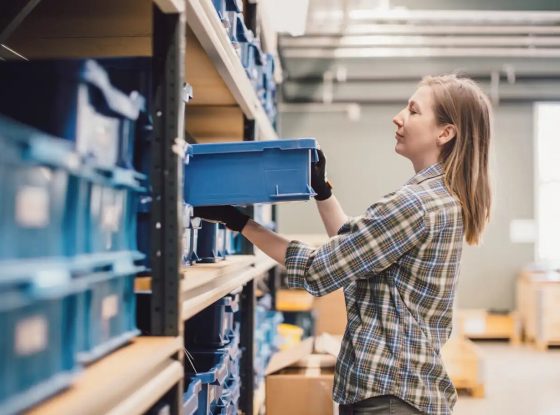8 innovations that are transforming supply chains

The supply chain is a complex, multi-faceted process encompassing everything from warehouse fulfillment to logistics. With many companies continuing to work towards supply chain optimization, the industry is ripe for innovation. As new technologies emerge that hold promise for streamlining fulfillment processes to speeding logistics, the traditional supply chain is rapidly transforming into a more advanced, more functional process driven by digital technology, artificial intelligence and other innovations. Listed in no particular order, here’s a look at eight of the most prominent supply chain innovation and innovation in logistics examples.
Last-mile delivery
Companies like UPS are developing innovative programs that aim to solve the last-mile delivery challenge. The company launched an electric bike program, eBike, which expedites deliveries in areas with limited parking. The program launched in Portland, Oregon and Pittsburgh, Pennsylvania, with the added bonus of reducing harmful emissions. Programs like UPS’ eBike support the demand for rapid delivery and enable companies to meet same-day and next-day delivery promises even in congested urban areas.
Self-service/do-it-yourself logistics

With self-service and do-it-yourself logistics programs like Amazon’s Flex program, individuals can launch and run their own logistics companies to deliver Amazon packages, even employing a fleet of drivers and vehicles if they choose. While self-service logistics programs don’t resolve the truck driver shortage problem, they do offer an alternative for companies that face challenges with traditional logistics services.
On-demand warehousing
On-demand warehousing, part of what’s considered the shared economy, is another supply chain innovation that addresses a common pain point — in this case, companies that need additional warehouse space temporarily but don’t want to take on the operating costs of opening a new warehouse facility. To solve this challenge, companies like Flexe connect companies in need of warehouse space with businesses that have space available. It’s a win-win, helping warehouse companies minimize operating costs by eliminating the need to expand for short-term needs, while offering participating warehouses an opportunity to monetize their available space.
Collaborative mobile robots

Collaborative mobile robots are the future of supply chain automation, as they offer greater flexibility and scalability compared to traditional warehouse automation and innovative supply chain solutions, increasing order picking efficiency and improving accuracy by guiding associates through tasks. By optimizing picking routes in real-time, collaborative mobile robots like 6 River Systems’ Chuck reduce unnecessary walking and improve warehouse productivity. Much like on-demand warehousing makes it possible to secure additional warehouse space as needed without infrastructure investments, companies can rent 6 River Systems’ collaborative mobile robots to increase capacity during peak, returning them when demand returns to normal.
Truck platooning
Truck platooning is an emerging concept that allows greater vehicle-to-vehicle communication, enabling trucks to travel at a closer distance than usual while in constant communication. Traveling closely reduces drag, which improves fuel efficiency, resulting in safer, more fuel-efficient transportation which can help to reduce logistics costs.
Blockchain
A blockchain is a permanent ledger of transactions that can improve transparency, reliability and efficiency in supply chains. While the concept of blockchain for the supply chain is still in development, it holds promise for all industries. In the pharmaceutical industry, for instance, where an estimated one million deaths each year are attributed to counterfeit medications and 30% of pharmaceuticals sold in developing markets are counterfeit, blockchain could potentially reduce this risk. Likewise, the automotive industry could use blockchain to track parts and identify counterfeits. Lab simulations show that blockchain could handle more than seven billion unique serial numbers and 1,500 transactions per second.
Tagging, sensors and geolocation technologies
Innovations like tagging, sensors and geolocation technologies go hand-in-hand with blockchain, providing real-time tracking of individual parts and goods to improve traceability and transparency. Using one such technology, RFID-IV, the U.S. Department of Defense tracks and monitors 24,000 high-value military assets worldwide, offering in-transit visibility and reliability while eliminating blind spots in the supply chain. This technology offers real-time alerts for issues such as tampering, delays or assets that enter or exit pre-determined geographical zones, allowing the DoD to implement contingency plans and mitigate delays.
Big data and AI
Supported by the real-time tracking technologies mentioned above, big data and artificial intelligence are also transforming the supply chain. In fact, it’s not the tracking devices themselves that make the DoD’s alerts possible, but tracking devices paired with cloud-based visibility and analytics platforms. With the use of IoT devices, companies can share supply chain information without the need for human interaction, and by leveraging big data, artificial intelligence technologies transform raw data into actionable insights that aid decision-making. A variety of supply chain innovations (such as collaborative mobile robots and drones) and even legacy functions like fleet optimization leverage AI for smarter decision-making.
These eight innovations certainly aren’t the only technologies shaking up the supply chain, but they are some of the most promising. Companies won’t stop innovating anytime soon, so even more innovative and new technologies in supply chain are on the horizon for the industry.
Source : 6river.com



